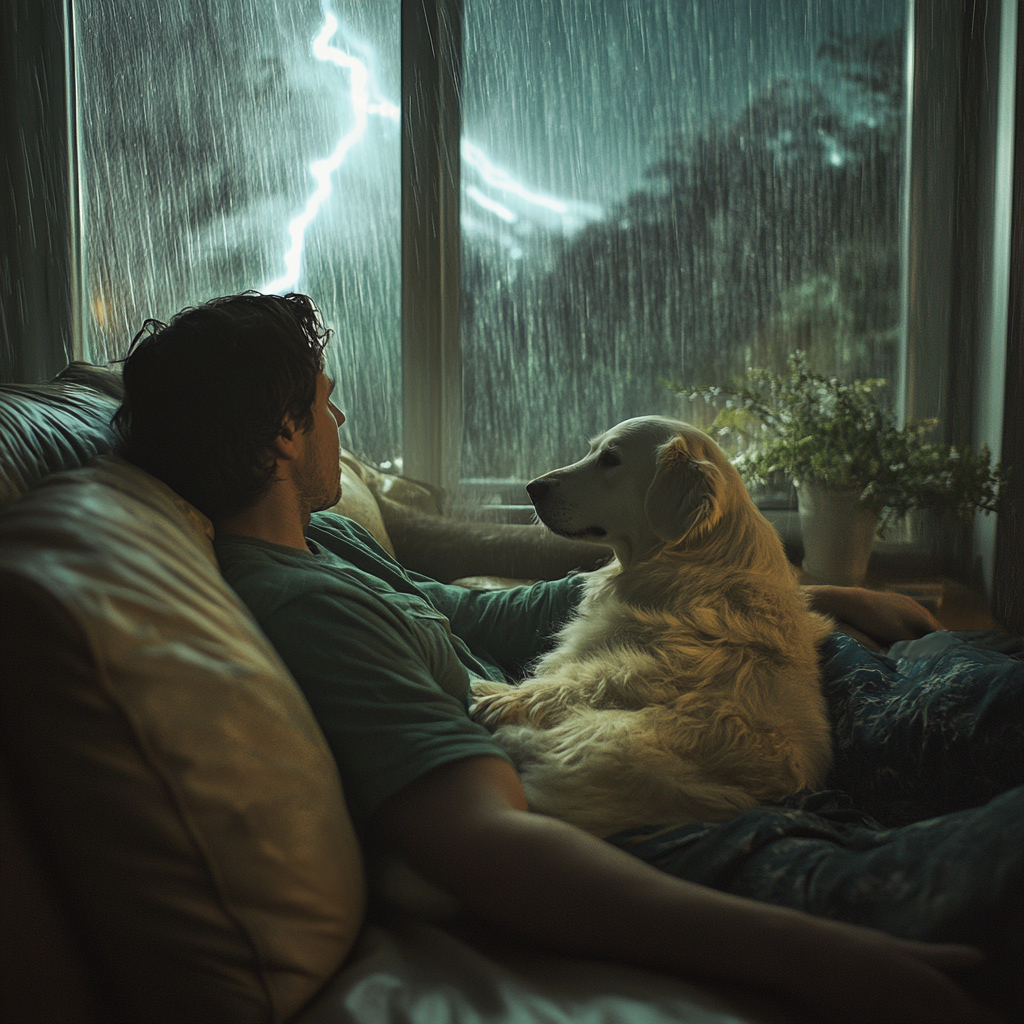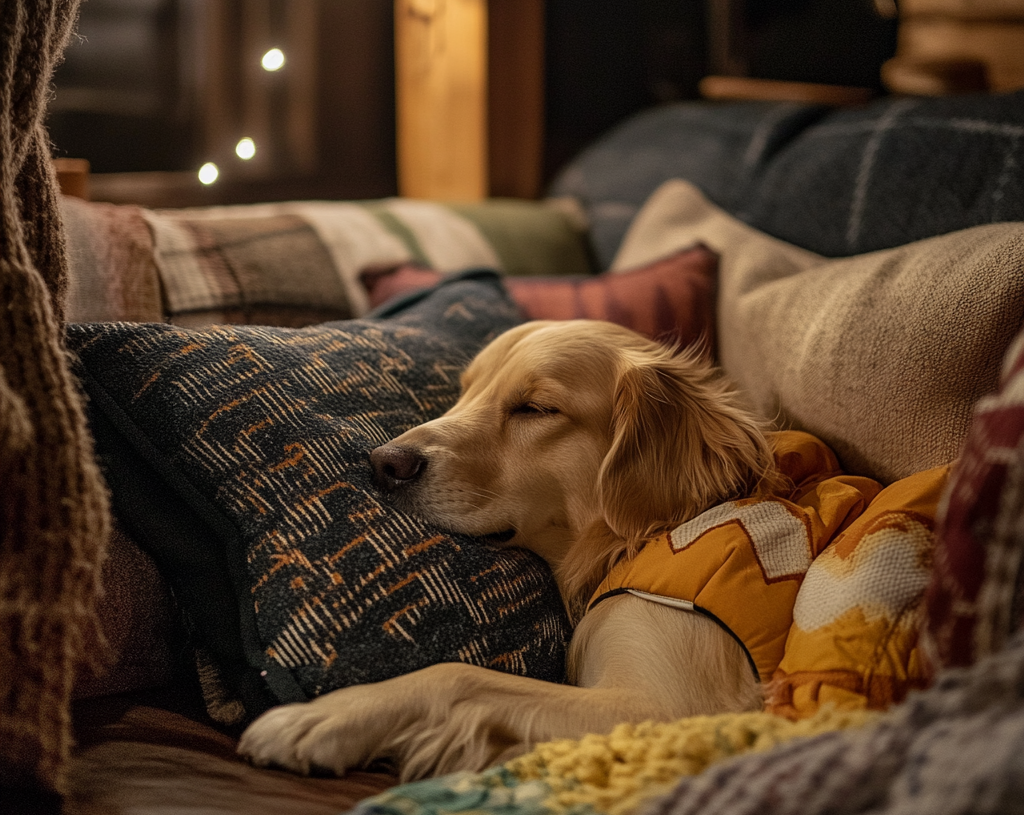Discover practical ways to calm a dog during a storm. Learn expert tips to reduce anxiety and help your dog stay safe and comfortable during thunderstorms.
How to Calm a Dog During s Storm: Effective Tips and Techniques

Table of Contents
- Introduction: Why Dogs Are Afraid of Storms
- Understanding Your Dog’s Anxiety During Storms
- How to Calm a Dog During a Storm: 10 Proven Techniques
- 3.1 Create a Safe Space for Your Dog
- 3.2 Use Calming Products
- 3.3 Provide Distractions and Comfort
- 3.4 Exercise Before the Storm
- 3.5 Desensitize Your Dog to Storm Sounds
- How to Calm a Dog During a Storm with Natural Remedies
- 4.1 Herbal Treatments for Storm Anxiety
- 4.2 Aromatherapy for Dogs
- Training Your Dog to Cope with Storms Over Time
- Professional Help: When to Seek a Vet’s Advice
- Conclusion
1. Introduction: Why Dogs Are Afraid of Storms
If you’ve ever seen your dog cower in fear or become frantic during a storm, you’re not alone. Many dogs suffer from storm anxiety, and it can be an incredibly stressful experience for both you and your pet. Understanding how to calm a dog during a storm is essential for the well-being of your furry friend. In this guide, we’ll explore the causes behind storm anxiety in dogs and provide you with practical tips to help ease their fears.
2. Understanding Your Dog’s Anxiety During Storms
Dogs react to storms in various ways, from trembling and whining to seeking hiding spots or even running away. The root cause of this anxiety is not fully understood, but several factors can contribute to a dog’s fear of storms:
- Loud noises: Thunderclaps, heavy rain, and wind can overwhelm a dog’s sensitive hearing.
- Static electricity: Some dogs are sensitive to the electrical energy in the air during storms.
- Change in barometric pressure: Dogs may be able to sense changes in weather, which can cause unease.
- Visual stimuli: Flashing lightning and strong winds can add to a dog’s stress.
Understanding these triggers is the first step to helping your dog. With the right tools and techniques, you can provide comfort and reassurance during a storm.
3. How to Calm a Dog During a Storm: 10 Proven Techniques
Now that we understand why dogs are afraid of storms, let’s dive into how to calm a dog during a storm with actionable tips and strategies.
3.1 Create a Safe Space for Your Dog
A safe space is crucial when trying to calm a dog during a storm. This space should be quiet, secure, and free from distractions. Many dogs feel safer in smaller, enclosed areas, so consider setting up a crate or a cozy corner where they can retreat when the storm begins.
- Use blankets or cushions to create a den-like atmosphere.
- Close curtains or blinds to block out lightning.
- Dim the lights to reduce visual stimuli.
A safe space can help your dog feel secure, which is the first step in calming them down.
3.2 Use Calming Products
There are various calming products on the market designed specifically for dogs with storm anxiety. These can be an effective way to calm a dog during a storm when used in conjunction with other methods.
- ThunderShirt: This pressure wrap applies gentle, constant pressure, which can have a calming effect.
- Calming collars: Some collars contain essential oils like lavender or chamomile, which can help soothe your dog.
- Calming sprays: Products like Adaptil, which contain synthetic pheromones, can mimic the calming effects of a mother’s presence.
When selecting a product, it’s essential to try out different options to see what works best for your dog.
3.3 Provide Distractions and Comfort
Sometimes, the best way to calm a dog during a storm is by distracting them from the noise and commotion outside. Offer comfort through:
- Interactive toys: Puzzle toys filled with treats can keep your dog occupied.
- Calming music: Play calming music or white noise to mask the sounds of the storm.
- Gentle petting: Calmly pet your dog to provide reassurance and physical comfort.
Distractions can be a powerful tool in breaking your dog’s focus on the storm and redirecting their attention to something more relaxing.
3.4 Exercise Before the Storm
A tired dog is often a calm dog. Before a storm hits, make sure your dog gets plenty of exercise. Whether through a walk, playtime, or training, physical activity can help reduce pent-up energy, which might otherwise exacerbate anxiety during a storm.
- Play fetch in the backyard.
- Take a walk around the block.
- Train your dog in obedience or new tricks.
The more exercise your dog gets, the less likely they are to be overly anxious during the storm.
3.5 Desensitize Your Dog to Storm Sounds
Desensitization can be an effective long-term strategy to help a dog get used to storm-related sounds. This involves gradually exposing your dog to recordings of thunder and storm noises at a low volume and rewarding calm behavior.
- Start with quiet sounds: Play a recording of storm sounds at a low volume.
- Gradually increase volume: Over time, increase the volume while continuing to reward your dog for calm behavior.
- Pair with positive reinforcement: Treats and praise can help reinforce calm responses.
With consistent practice, your dog may become less reactive to storm sounds over time.
4. How to Calm a Dog During a Storm with Natural Remedies
For pet owners who prefer natural solutions, there are several remedies that can help calm a dog during a storm.
4.1 Herbal Treatments for Storm Anxiety
Herbal supplements can help promote relaxation in dogs. Some popular options include:
- Valerian root: Known for its calming properties.
- Chamomile: Can be soothing and calming for dogs with anxiety.
- Lavender: Often used in aromatherapy and known for its stress-reducing effects.
Before giving any herbal supplements, consult with your veterinarian to ensure they’re safe and appropriate for your dog.
4.2 Aromatherapy for Dogs
Aromatherapy can be another effective method to calm a dog during a storm. Essential oils like lavender, chamomile, and frankincense can have a calming effect. You can use an essential oil diffuser or apply diluted oils to your dog’s bedding or collar.
Important: Always consult with your vet before using essential oils, as some can be harmful to dogs when used incorrectly.
5. Training Your Dog to Cope with Storms Over Time
While immediate relief methods are essential, long-term training can be crucial for dogs who experience consistent anxiety during storms. Using positive reinforcement and desensitization techniques can help reduce storm-related fear over time.
- Start training early: The earlier you begin desensitization, the more successful it will be.
- Be patient: It may take several months to see significant progress.
- Use a consistent approach: Stick to a training routine and avoid reinforcing anxious behavior.
6. Professional Help: When to Seek a Vet’s Advice
If your dog’s storm anxiety is severe or persists despite your efforts, it’s time to consult with a veterinarian. In some cases, medication or specialized therapy may be necessary to help manage anxiety.
- Behavioral therapy: A veterinary behaviorist can work with you and your dog to develop a tailored plan.
- Medications: Anti-anxiety medications, such as fluoxetine or alprazolam, can help reduce severe anxiety in some dogs.
A professional can guide you in the right direction to ensure your dog gets the best care possible.
7. Conclusion
Learning how to calm a dog during a storm is a vital skill for any pet owner. By understanding your dog’s triggers, creating a safe space, and using calming techniques, you can help ease their fear and make thunderstorms more manageable for both of you. Whether through exercise, distractions, calming products, or natural remedies, there are plenty of ways to provide comfort and security.
For more pet-related articles, click here [https://ledstk.com/category/pets/] and for recipe lovers, see here [https://sotastyrecipe.com].
